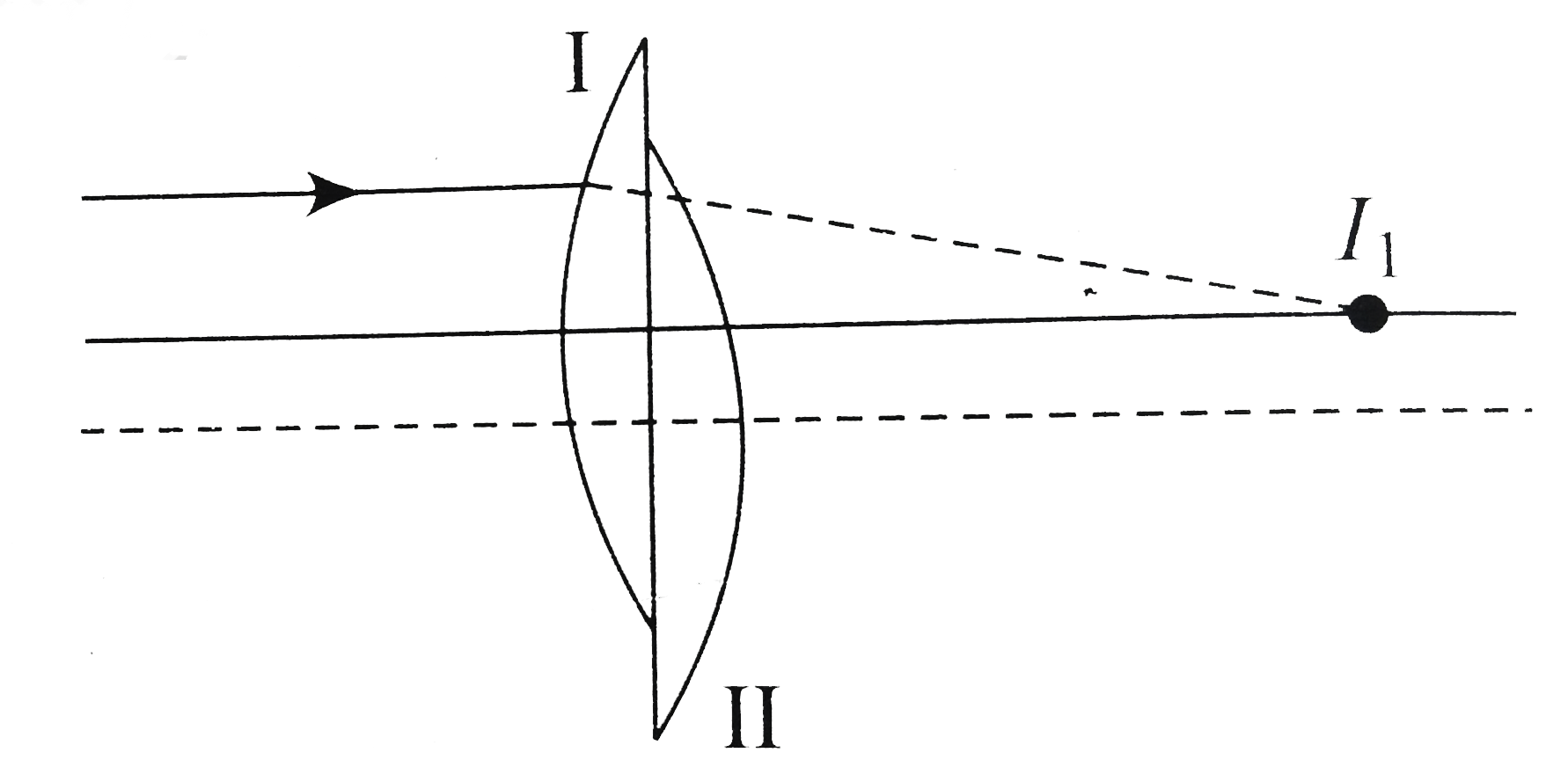Two identical plano-convex lenses L1(μ1−1.4) and L2(μ2−1.5) of radii of curvature R=20cm are placed as shown in Figure.

Q. Now, the secocnd lens is shifted vertically downward by a small distance 4.5mm and the extended parts of L1 and L2 are blackened as shown in figure. Find the new position of the image of the parallel beam.

200/9 cm behind the lens 2.5 mm below the principal axis of L1
100/9cm in front of th elens 2mm below the prinicipal axis of L1
200/9cm in front of the lens 2.5mm below the principal axis of L1
100/9cm behind the lens 2mm below the princiipal axis of L1
The correct Answer is:a.
a. Focal lengths of lenses L1 and L2 are, respectively, given by
1f1=(μ−1)(1R−1∞)⇒f1=50cm
1f2=(μ−1)[1∞−(−1R)]⇒f2=40cm
The equivalent focal length f of the combination is given by
1f=1f1+1f2⇒f=2009cm
Hence, the image of the parallel beam is formed on the common principal axis at a distance of 22.22cm from the combination on the right side.
b. Image formed by L1 is at a distance of 50cm behind the lens. This image lies on the principal axis of L1 and will act as an object for L2
For L2, object distance, u=+50cm
f2=+40cm
1υ−1u=1f⇒μ=2009cm
Magnification caused by L2,m=υu=49
For L2 object I1 is at a distance of 4.5mm above its principal axis.
Hence, distance of image I2 of the object (virtual) I1 is at a distance (4/9)×4.5=2mm above the principal axis of L2
[∴height of image=m×height of object]
Hence, final image is at a distance of 22.22cm behind the combination at a distance of 2.5mm below the principal axis of L1.

Topper's Solved these Questions
- GEOMETRICAL OPTICSBOOK - CENGAGE PHYSICS ENGLISHCHAPTER - GEOMETRICAL OPTICSEXERCISE - Integer
15 Videos
- GEOMETRICAL OPTICSBOOK - CENGAGE PHYSICS ENGLISHCHAPTER - GEOMETRICAL OPTICSEXERCISE - Archives
7 Videos
- GEOMETRICAL OPTICSBOOK - CENGAGE PHYSICS ENGLISHCHAPTER - GEOMETRICAL OPTICSEXERCISE - Assertion-Reasoninig
2 Videos
- ELECTRON,PHONTS,PHOTOELECTRIC EFFECT & X-RAYSBOOK - CENGAGE PHYSICS ENGLISHCHAPTER - ELECTRON,PHONTS,PHOTOELECTRIC EFFECT & X-RAYSEXERCISE - dpp 3.3
15 Videos
- HEATING EFFECT OF CURRENTBOOK - CENGAGE PHYSICS ENGLISHCHAPTER - HEATING EFFECT OF CURRENTEXERCISE - Thermal Power in Resistance Connected in Circuit
27 Videos
Similar Questions
Two identical plano-convex lenses L1(μ1−1.4) and L2(μ2−1.5)
of radii of curvature R=20cm are placed as shown in Figure.

Q. Find the position of the image of the parallel beam of light relative to the common principal axis.
View SolutionA plano-convex glass lens (μg=3/2) of radius of curvatureR=10cm is placed at a distance of b from a concave lens of focal length 20cm. What should be the distance a of point object O from the plano-convex lens so that position of final image is independent of b?

View Solution
Knowledge Check
A double convex lens made of glass of refractive index 1.56 has both radii of curvature of magnitude 20cm. If an object is placed at a distance of 10cm from this lens, find the position of image formed.
A22.86 same side of the objectB22.86 opposite side of the objectC44.89 same side of the objectD44.89 opposite side of the object.
A plano-concave lens is made of glass (R.l. = 1.5) and the radius of curvature of the curved face is 50 cm. The power of the lens is
View SolutionIn the figure shown, there are two convex lenses L1 and L2 having focal. Lengths f1 and f2 respectively. The distance between L1 and L2 will be

View SolutionA double convex thin lens made of glass (refractive index μ=1.5) has both radii of curvature of magnitude 20 cm . Incident light rays parallel to the axis of the lens will converge at a distance L such that
View SolutionA double convex thin lens made of glass (refractive index μ=1.5) has both radii of curvature of magnitude 20 cm . Incident light rays parallel to the axis of the lens will converge at a distance L such that
View SolutionTwo inductors L1 and L2 are connected in parallel and a time varying current flows as shown.
the ratio of current i1/i2

View SolutionAn object of height 1mm is placed inside a sphere of refractive index μ=2 and radius of curvature 20 cm as shown in the figure. Find the position, size, and nature of image, for the situation shown in Figure. Draw ray diagram.

View SolutionIn a laboratory four convex lenses L1,L2,L3 and L4 of focal lengths 2,4,6 and 8cm respectively are available. Two of these lenses form a telescope of length 10cm and magnifying power 4 . The objective and eye lenses are
View Solution
